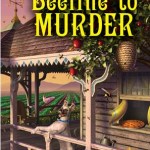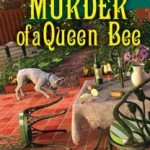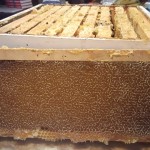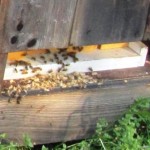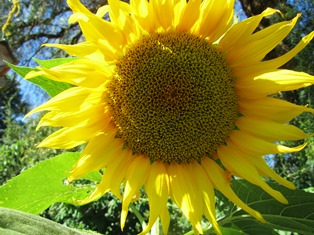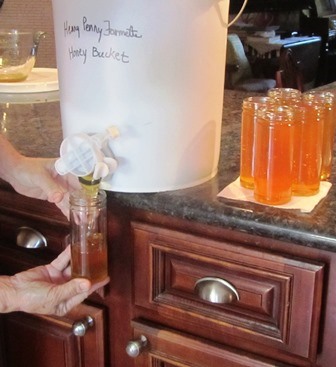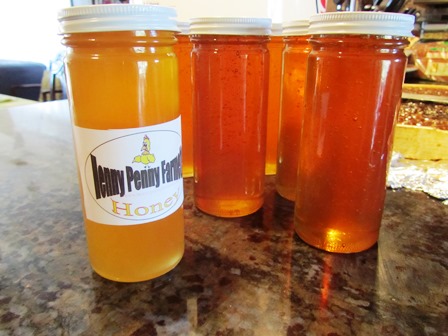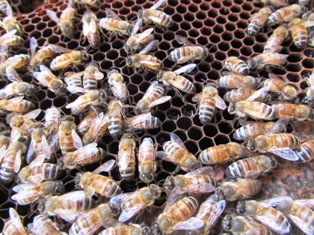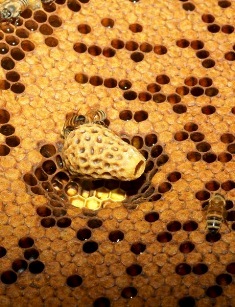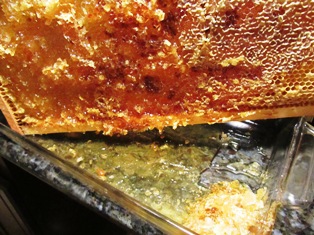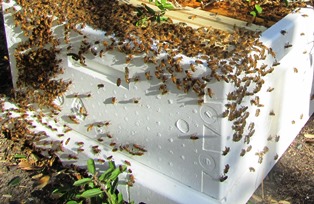Transplanting a Decades-Old Crape Myrtle Tree
Friends said it was a bad idea. The tree was too large, too old, and too unwieldy to dig up and transport from my daughter’s property to mine. The crape myrtle would not survive, they told me, because its large root would need to be severely cut. Also, without a crane or other lifting device, three of us would be struggling to deal with such a heavy tree.
I won’t say moving the tree was easy. It had been standing for 28 years next to my daughter’s house, but she wanted to make way for new landscaping. When the family decided to part with the tree, they called on a family friend who worked as an arborist. He would do the cutting and digging of the tree.
Crape myrtles (of the genus, lagerstoemia) are available as shrubs and trees and are lovely in bloom with showy paniculate flowers in pink, fuchsia, red, or lavender. They are one of the trees that make little-to-no pollen (great for allergy sufferers). Light pruning during the growing season can produce a second bloom. Much beloved in the deep south, these trees remain stately and beautiful for up to fifty years.
My daughter’s tree arrived at the farmette in mid-October strapped onto our friend’s truck. The roots had been cut away. There were no fine root hairs or stems left–just bare wood. Ditto for the tree canopy–just a few hefty branch stubs. I wondered if our efforts would prove futile.
Hubby and I prepared a large planting hole just off from the patio. We added amendments to the clay soil and drove in stakes to keep the tree stable for a year or more until it had sufficiently developed roots. I added root hormone to the soil and watered deeply the first day and several times that week.
The winter rains came. I watched, waited, and wondered if there would ever be sprouting of any kind on the woody ends where branches had been amputated. Despite a canopy, the tree’s trunk, a beautiful, gray-green wood, afforded a kind of beauty to the austere winter garden. Before spring, I scraped a fingernail on the back of the trunk and discovered the wood was not dried out but as green and moist as a young sapling.
A spell of warm weather and the buzzing of bees in early spring drew my attention upward. Our tree had sprouted a flurry of bronze-green leaves. Pink blooms will likely appear in June or July.
I’m happy now that we went to all the trouble of bringing that tree onto the farmette for transplanting. We’ll have lovely pink blooms over the remaining summers of my life thanks to the crape myrtle tree being so long-lived.
__________________________________________________________________
If you enjoy reading about gardening and farming topics, check out my Henny Penny Farmette series of mysteries: A BEELINE TO MURDER, THE MURDER OF A QUEEN BEE, and A HIVE OF HOMICIDES (Kensington Publishing).
Each book is chocked full of tips for gardening, keeping bees and chickens, and growing heirloom fruits and vegetables. There are also plenty of delicious recipes to try. Find these books on Amazon.com, Barnes & Noble.com, Walmart.com and other online retailers or purchase at traditional bookstores everywhere.–Meera Lester
De-Bugging My Honeybee Hive Box of Beetles
I’ve been dealing with a beetle problem in my honeybee hive since fall. When my knowledgeable beekeeper neighbor called to suggest opening the hive, I readily agreed.
The dreaded hive beetle–tinier than a honeybee–can destroy a hive. Its destruction isn’t on the bees themselves, but rather the comb, honey, and pollen. As the population of hive beetle increases and the destruction mounts, the bees will abandon the hive.
Previously, my neighbor had used two types of hive beetle traps in my hive–Beetle Bee-Gone was an all-natural, chemical-free sheet that looked like a fabric softener product for the dryer. We had placed this on top of the frames before closing the hive last fall. The other product was a narrow plastic tray inserted between the frames that held vegetable oil.
We discovered that the sheet worked well, trapping lots of hive beetles. But the frame with oil had no beetles. I dumped it. We checked the brood box–and were excited to see it full of unborn babies.
After harvesting eight frames of honey, we reversed the brood box, scraped away the burr comb, and positioned a super on top of the hive box with empty frames for spring honey. Before closing the hive, we inserted two clean sheets of Beetle Bee-Gone.
Today, the bees are active and out foraging for pollen. Flowers are everywhere and the fruit trees in the neighborhood have broken bud. It remains to be seen if the Bay Area gets any more rain or bitterly cold days ahead. Probably by April 1, I’ll hang the swarm catcher and hope to add a new population of bees to my colony.
______________________________________________________________________________
If you enjoy reading about keeping bees, growing heirloom vegetables and fruits, caring for chickens, or self care for healthy living, check out my Henny Penny Farmette series of cozy mysteries: A BEELINE TO MURDER, THE MURDER OF A QUEEN BEE, and HIVE OF HOMICIDES. Click on the URL below. Also see newest nonfiction for healthy living: RITUALS FOR LIFE.
http://tinyurl.com/ya5vhhpm
Giant Sunflowers Brighten a Garden, Cornfield, or Wall
Ralph Waldo Emerson once observed, “The earth laughs in flowers.” Among the many flowers I plant around the Henny Penny Farmette each year, sunflowers are my favorites.
What’s not to love about these gorgeous beauties that inspired master artists like Van Gogh, Monet, and Gauguin as well as farmers like my grandmother who put them in fruit jars and crockery to brighten the rooms of her Missouri farmhouse?
I like to grow smaller ones at the back of a flower bed and the giant ones against walls or at the back of my patch of summer corn.

These sunflowers stand about 12 feet tall and produce several heads. Heritage varieties produce several heads.
Giant sunflowers need space to grow to full size since they will grow well over six feet. In my garden, they tower over the corn. Bees love them for their pollen. Kids love them when the foliage of the plants create a secret fort or a fairy circle. Humans, birds, and squirrels love them for their seeds.
For best results, plant giant sunflowers at the back of a garden. They need good soil and full sun. Plant when the danger of frost has past. A rule of thumb to follow is to plant them about one inch deep and six inches apart. While the seeds are germinating, keep the soil moist.
Later on, when the plants stand about three inches tall, you can thin them. Leave about one foot between each plant. This enables a strong root system for form. The stalks will become sturdy and measure about three to four inches in circumference when fully grown.
First come the gorgeous petals in green to yellow and then bright yellow. As the bees pollinate the florets and they drop, the seeds will mature. Seeds are either gray or brown in color.
I always cut the heads when the seeds are plump, firm, and begin to drop. I let the heads dry well in the sun for days before I remove the seeds. Fully dry seeds can be stored in containers for human consumption or to be fed to the squirrels and birds. Don’t forget to save some for planting in next year’s garden.
* * *
If you enjoy reading about farmette topics (including gardening, beekeeping, and delicious recipes), check out my cozy mysteries A BEELINE TO MURDER and also THE MURDER OF A QUEEN BEE in the Henny Penny Farmette series (from Kensington Publishing).
These novels are available through online retailers such as Amazon, Barnes & Noble, Kobo Books, and Walmart as well as from traditional bookstores everywhere.
See, http://tinyurl.com/hxy3s8q
Now available in mass market paperback, this debut novel launched the Henny Penny Farmette series of mysteries and sold out its first press run.
See, http://tinyurl.com/h4kou4g
The second cozy mystery in the Henny Penny Farmette series, available Sept. 27, 2016, is now available on Net Galley (netgalley.com) for professionals and readers who write reviews.
A Good Day to Strain, Drain, and Bottle Honey
It’s Sunday. I’m bottling the honey that I pulled from the hives last week. Yesterday, I washed two dozen eight-ounce jars in the dishwasher and allowed them to dry upside down on paper towels. Today, I’ll put on my apron and listen to some energetic big band tunes while I drain that honey into jars.
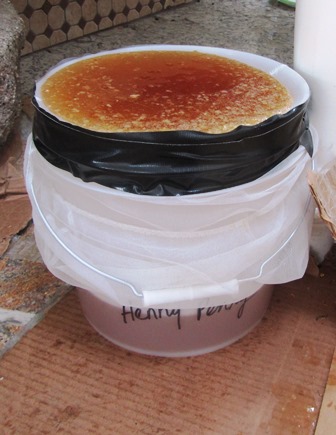
The fine mesh strainer taped tightly around the bucket rim traps the bits of wax but does not impede the flow of honey
My buckets of honey still have duct tape around their rims holding the strainers in position. When the honey was spun in the extracting machine, it had to be drained through a filter. Painter’s filters work great as the mesh cloth is very fine and fits over the top of the bucket.
The filter is placed into position around the rim and then duct taped is wrapped around tightly two times. Honey is quite heavy and can pull down the filter if not secured. I’m straining the honey that goes into jars. However, I did save back a jar of unfiltered honey with all those bits in it for a family member who prefers it that way.
The work was easier and went faster than I’d expected. It helps to have everything you need close at hand, clean, and ready to go.
Of the three large buckets, the first had a nice spigot than I could turn off after I allowed honey to flow and fill the jar. Then I closed the spigot, wiped the jar with a damp paper towel, and then screwed the lid in place.
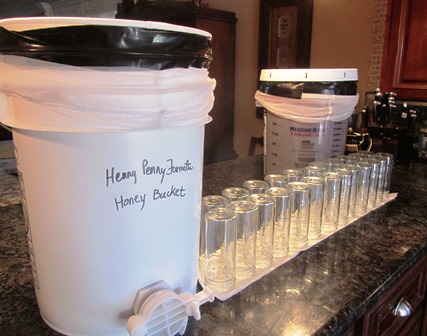
This five-gallon honey bucket will fill approximately five dozen eight-ounce jars; pictured here are 24 jars
The two dozen eight-ounce jars barely made a dent in my first honey bucket although my neighbor tells me that I can easily fill five dozen of the eight-ounce jars from one five-gallon bucket; or, I can fill two and one-half dozen of the sixteen-ounce jars.

Filled jars reveal clear, light amber honey the bees made from the French perfume lavender on my farmette and our springtime flowers, but these jars still labels
The next step in the process is to affix my Henny Penny label onto the jar. I plan to give some of these jars away during promotions in early October for my forthcoming novel, A BEELINE TO MURDER, the first in the Henny Penny Farmette series of cozies.
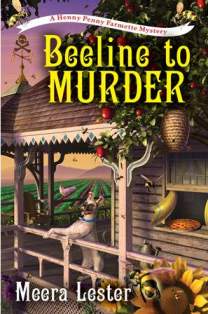
Published next month by Kensington, my book is available on Amazon, Barnes & Noble, and through most booksellers and online bookstores
If you are interested in this honey, please feel free to email me at meeralester1@gmail.com.
Letting Gardens Dry Up Is Hard On the Honeybees
My neighbor, a world-class beekeeper whose honey sells to many specialty markets and also Whole Foods, told me today honeybees in backyard hives in our East Bay communities are hungry. He has put out two five-gallon cans of sugar water to feed his bees.
Interestingly, I’ve noted bees at my hummingbird feeders also usurping the sugar water meant for the hummingbirds.
The honeybees do not make honey from sugar water. They just consume it to have energy to forage for pollen and to cool the hives on hot days. The drought means people are watering less; flower gardens and local landscape are dry, and in places the clay soil is cracking open. Bad news for bees.
Weatherwise, it’s been triple-digit hot and then cold and cloudy. I guess the bees will adapt but old timers say, “A swarm in July means bees go bye-bye.” This isn’t the right time for swarming.
My hived bees are loud and energetic. The bees faked me out with a small swarm about ten days ago and then returned to the hive; and now they are eating sugar water for energy to gather what pollen they can find to make honey. The honey will see the hungry hive through until the star thistle and the fall eucalyptus blooms. I’m torn between letting my bee-loving flowers dry up to conserve water, but I don’t want to lose my bees.
What to Do When Ants Invade the Honey Bucket
My five-gallon honey bucket with the spigot makes it easy for me to fill up a jar of honey for friends or family. For easy access, I keep it on a round table in the kitchen.
Yesterday morning, I went to refill our own empty jar and noticed ants on the exterior of the bucket. It has a lid on it, but not too tight-fitting, so I held my breath and pulled off the lid.
Removing the lid, I found the ants had infiltrated it and hundreds floated in the honey. Imagine my dismay.
I consulted with my beekeeper neighbor about what to do with the now-unusable honey. Much to my surprise, he said save it. He told me to put it in the freezer (the one specifically used to freeze frames and therefore kill any pests we can’t see on the wax before returning those frames to the hives). So the bucket with the ants went into the freezer I keep on the patio.
My neighbor says the ants will die. The bees can then eat that honey when there isn’t enough pollen around, for example, during the winter. It’s a win-win . . . except for the ants.
Sixty Pounds of Honey, Death of Some Drones, and a New Swarm
I opened my hives this past Sunday with the help of my world-class beekeeper neighbor. We checked on the the condition of eggs, the number of new queens, the growth of baby bees, the presence of mites (none detected), and the amount of honey (lots).
The male bees (the drones) over the last weeks have been engaged in some crazy flight patterns in front of the hive as the mating of the queen takes place. The old queen has done her egg laying and the hives have lots of babies with nurse maids and other worker bees. From the hives comes the clearly audible sound of humming and the fragrant scent of honey.

The drone (male bees) are vital for mating with the queen; after that, they are unnecessary and are eliminated
The drones are not now needed and the workers in the colony are doing away with them. I found a stack of drones at the front door of the hive this morning. Strange sight to see, indeed. But no more so than the many queen houses (formed from honeycomb by the worker bees). These houses are where the new queens are nourished; each contains royal jelly.
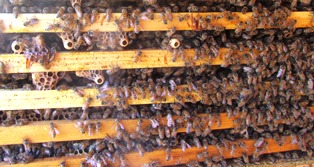
The tubular circles are the houses where the baby queens will be cared for by the workers. The houses contain royal jelly for the feeding of the new queens
My neighbor told me to wait three more weeks to take honey, but since I didn’t take any honey during the fall/winter and there were huge stores of it in my hives and coupled with the fact that there’s a plethora of flowers now to provide pollen for the bees, we decided it would be okay to remove some frames. So, I took six frames (weighing roughly ten pounds each) from the hives.
The honey I harvested has a pale lemony color–significant for the wildflowers and almond and fruit tree blossoms from which the bees collected the pollen to make that honey. In the fall, the honey is darker and earthier tasting, thanks to pollen from the star thistle and eucalyptus blooms.
When we had finished with my hives and walked back to my neighbor’s house, we spotted a swarm overhead. We grabbed the pots and wooden spoons and started banging. The bees took refuge in the tall pepper tree and that’s where my neighbor rescued them. In all, it was quite a spectacular Sunday!
Giant Sunflowers Provide Food and Fun for Everyone
Giant sunflowers need space to grow to full size; they can reach six or more feet tall. Bees love them for their pollen. Kids love them when the foliage of the plants create a secret fort or a fairy circle. Humans, birds, and squirrels love them for their seeds.
For best results, plant giant sunflowers at the back of a garden. They need good soil and full sun. Plant when the danger of frost has past. A rule of thumb to follow is to plant them about one inch deep and six inches apart. While the seeds are germinating, keep the soil moist.
Later on, when the plants stand about three inches tall, you can begin to thin them. Leave about one foot between each plant. This can enable a strong root system for form. The stalks will become sturdy and measure about three to four inches in circumference when fully grown.
First come the gorgeous petals in green to yellow and then bright yellow. As the bees pollinate the florets and they drop, the seeds will mature. Seeds are either gray or brown in color.
I always cut the heads when the seeds are plump, firm, and begin to drop. I let the heads dry well in the sun for days before I remove the seeds. Fully dry seeds can be stored in containers for human consumption or to be fed to the squirrels and birds.
* * *
If you enjoy reading about farmette topics (including gardening, beekeeping, and delicious recipes), check out my cozy mysteries A BEELINE TO MURDER and also THE MURDER OF A QUEEN BEE in the Henny Penny Farmette series (from Kensington Publishing).
These novels are available through online retailers such as Amazon, Barnes & Noble, Kobo Books, and Walmart as well as from traditional bookstores everywhere.
See, http://tinyurl.com/hxy3s8q
Now available in mass market paperback, this debut novel launched the Henny Penny Farmette series of mysteries and sold out its first press run.
See, http://tinyurl.com/h4kou4g
The second cozy mystery in the Henny Penny Farmette series, available Sept. 27, 2016
Time to Open the Hives, Check on the Bees
My honeybees have become surprisingly active for the dead of winter. Local forecasters tell us that the Bay Area temperatures may reach 80 degrees Fahrenheit by the end of the week. My apple and early peaches won’t wait; they’ve already blossomed.
The warm weather, time of year together with the fact that almond trees will be blooming in a couple of weeks and the lavender around my farmette is already blooming tells me I have to open the hives. My beekeeper neighbor says that his bees are already out collecting pollen–lots of it–and that means we have to get to work.
The hives have to be checked now for mold (that long period of hard rain in December caused some of my neighbor’s frames to mold). Moldy frames can’t be renewed; they have to be tossed. Honeybees can get nosema (with diarrhea), which shows up as spots at the base of the hive.
The bees are finding flowers on their forage runs and are returning to the hive laden with pollen.
Bee queens will be busy laying eggs in the coming weeks, if they aren’t already. This is the time for beekeepers to purchase new queens. By the first week in April, it’s possible we could see swarming.
So here’s the plan. If the hives have a lot of honey, I’ll harvest some. Strange to be doing that in winter, but the hive will need space for brood. I’ll have to remove frames of honey and insert empty frames with wax (put in the freezer first for a period to kill any pest they might be harboring over).
I’ll put bee food patties in the open hives, so they’ll have plenty to eat (once I take some of their honey). My beekeeper neighbor tells me this will get the hive “heated up” for the queen to do what she does best–lay the eggs.
With so much activity, I’m confident that everything will turn out well, but you never know until you’ve inspected the interior of the hive and checked out everything, including the possibility of mold or the presence of pests or illness.
Mother Nature didn’t ask me, but I would have preferred she wait another month before removing her winter robes and dressing in spring florals. It just seems like now everything to do with the hives is on fast forward!
Honeybee Hive Pests Include Real Vampires
Every beekeeper wants to keep his or her hives healthy. Staying on top of your bee’s health means early detection and treatment of pests in the hive such as Varroa mites, trachea mites, hive beetles, and wax moths.
Varroa mites–these small reddish brown pests are akin to tiny vampires, feasting on your bees’ blood. Non-medicinal approaches to treating for these mites include introducing a screened bottom board. Mites fall through and cannot re-enter the hive to reattach to the bees. Also a powdered sugar dusting of your hives’ top bars can dislodge mites.
Tracheal mites–these pests are more difficult to detect. My beekeeper neighbor showed me infant baby bees with partial wings and said he believed it was the work of tracheal mites. To rid your hives of these pests, you’ll need to use menthol crystals and grease patties.
Hive beetles–if you see an insect with a hard, small black shell in corners and dark places within the hive, you may have hive beetles. They devour bee brood, honey, wax, and pollen. Treat the soil in front of the hive and inside the hive, you can try hive beetle traps or treat chemically. The infected honey will be rejected by the bees and should be considered unfit for human consumption as well.
Wax moths–these nasty little creatures can been seen in honeycomb and leave a silky trail over your hive’s hanging frames. If you see evidence that they’ve tunnel into the wood, know that you’ve had the infestation for a while. Wax moths will weaken a colony. Treat the infected hives with moth crystals formulated to eliminate wax moths in the hive.
Hives that are frequently checked their beekeepers stand the best chance for having healthy colonies of bees.
 Facebook
Facebook Goodreads
Goodreads LinkedIn
LinkedIn Meera Lester
Meera Lester Twitter
Twitter






